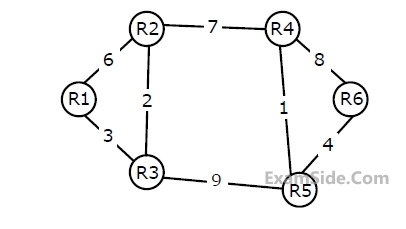Marks 1
Consider the routing protocols given in List-I and the names given in List-II:
| List - I | List - II | ||
|---|---|---|---|
| (i) | Distance vector routing | (a) | Bellman-Ford |
| (ii) | Link state routing | (b) | Dijkstra |
For matching of items in List-I with those in List-II, which ONE of the following options is CORRECT?
Which of the following statements is/are INCORRECT about the OSPF (Open Shortest Path First) routing protocol used in the Internet?
[S1] The computational overhead in link state protocols is higher than in distance vector protocols.
[S2] A distance vector protocol (with split horizon) avoids persistent routing loops, but not a link state protocol.
[S3] After a topology change, a link state protocol will converge faster than a distance vector protocol.
Marks 2
A packet with the destination IP address 145.36.109.70 arrives at a router whose routing table is shown. Which interface will the packet be forwarded to?
| Subnet Address | Subnet Mask (in CIDR notation) |
Interface |
|---|---|---|
| 145.36.0.0 | /16 | E1 |
| 145.36.128.0 | /17 | E2 |
| 145.36.64.0 | /18 | E3 |
| 145.36.255.0 | /24 | E4 |
| Default | $-$ | E5 |
Consider a network with three routers P, Q, R shown in the figure below. All the links have cost of unity.

The routers exchange distance vector routing information and have converged on the routing tables, after which the link Q-R fails. Assume that P and Q send out routing updates at random times, each at the same average rate. The probability of a routing loop formation (rounded off to one decimal place) between P and Q, leading to count-to-infinity problem, is _____________

The network uses a Distance Vector Routing protocol. Once the routes have stabilized, the distance vectors at different nodes are as following
N1 : ( 0, 1, 7, 8, 4 )
N2 : ( 1, 0, 6, 7, 3 )
N3 : ( 7, 6, 0, 2, 6 )
N4 : ( 8, 7, 2, 0, 4 )
N5 : ( 4, 3, 6, 4, 0 )
The cost of link N2 - N3 reduces to 2 in (both directions). After the next round of updates, what will be the new distance vector at node, N3?

The network uses a Distance Vector Routing protocol. Once the routes have stabilized, the distance vectors at different nodes are as following
N1 : ( 0, 1, 7, 8, 4 )
N2 : ( 1, 0, 6, 7, 3 )
N3 : ( 7, 6, 0, 2, 6 )
N4 : ( 8, 7, 2, 0, 4 )
N5 : ( 4, 3, 6, 4, 0 )
After the update in the previous question, the link N1-N2 goes down. N2 will reflect this change immediately in its distance vector as cost, $$\infty $$. After the NEXT ROUND of update, what will be the cost to N1 in the distance vector of N3?
Consider a network with 6 routers R1 to R6 connected with links having weights as shown in the following diagram

All the routers use the distance vector based routing algorithm to update their routing tables. Each router starts with its routing table initialized to contain an entry for each neighbour with the weight of the respective connecting link. After all the routing tables stabilize, how many links in the network will never be used for carrying any data?
Consider a network with 6 routers R1 to R6 connected with links having weights as shown in the following diagram
 Suppose the weights of all unused links in the previous question are changed to 2 and the distance vector algorithm is used again until all routing tables stabilize. How many links will now remain unused?
Suppose the weights of all unused links in the previous question are changed to 2 and the distance vector algorithm is used again until all routing tables stabilize. How many links will now remain unused?